C
| a type of schedule given out periodically during a film's production to let every department know when they are supposed to arrive and where they are to report; usually refers to a listing of actors necessary for scenes | 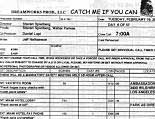 Example: the call sheet from Spielberg's Catch Me If You Can (2002) Example: the call sheet from Spielberg's Catch Me If You Can (2002) |
|
| originally meaning "a small piece of artwork," refers to a bit part (usually a brief, non-speaking or walk-on role that is uncredited or unbilled) or special screen appearance by a famous actor, director, or prominent person who would ordinarily not take such a small part; contrast to a bit part; also refers to a type of camera shot in which the subject is filmed against a black or neutral background. See Directors' Cameos. |
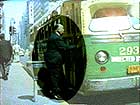 Examples: Alfred Hitchcock's witty, trademark cameos in his own films such as in North by Northwest (1959); and the many cameos in Robert Altman's The Player (1992), and in Austin Powers in Goldmember (2002); other directors with cameos (Roman Polanski, Francis Ford Coppola, Martin Scorsese, Walter Huston); also other examples include Ted Knight in Psycho (1960), and Sylvester Stallone in Bananas (1971) Examples: Alfred Hitchcock's witty, trademark cameos in his own films such as in North by Northwest (1959); and the many cameos in Robert Altman's The Player (1992), and in Austin Powers in Goldmember (2002); other directors with cameos (Roman Polanski, Francis Ford Coppola, Martin Scorsese, Walter Huston); also other examples include Ted Knight in Psycho (1960), and Sylvester Stallone in Bananas (1971) |
|
| the basic machine involved in film-making, from a hand-held version to portables, to heavy studio cameras; some of the parts of a camera include the aperture, lens, film magazine (for storage), viewfinder, etc; the positioning of the camera by the camera operator is known as the setup |  Example: a film camera |
|
| the point of view (POV) or perspective (including relative height or direction) chosen from which to photograph a subject. Various camera angles, compositions, or positions include: front, behind, side, top, high (looking down), low (looking up), straight-on or eye-level (standard or neutral angle), tilted (canted or oblique), or subjective, etc.; see also framing |  Example: Extreme camera angles can be found in The Third Man (1949). |
|
| the use of the camera to obtain various camera angles and perspectives. (See motion picture camera shots below, including the pan, tilt, track, and zoom; also boom/crane shots, Steadicam, or hand-held) | ||
| the individual who is responsible for operating the camera, under the direction of the film's directorand director of photography (or cinematography) | ||
(or campy) |
a type of comedy parody wherein conventional (and especially overused or clichéd) situations and plot devices are intentionally exaggerated to the point of absurdity to produce humor |  Examples: The Rocky Horror Picture Show (1975)and Barbarella (1968). |
("in the can") |
refers to the round metal/plastic container that holds or stores film (reels) for transport or for long-term storage; a film that has been completed is known colloquially as "in the can"; canned means pre-recorded; also see reel |
 A film can (or canister) with reel of film inside |
| refers to lighting that is provided by candlelight, to provide a warm hue or tone, and connote intimacy, romance, and harmony |  Example: Stanley Kubrick's period costume drama Barry Lyndon (1975) was largely filmed with natural light and candlelight Example: Stanley Kubrick's period costume drama Barry Lyndon (1975) was largely filmed with natural light and candlelight |
|
| a short movie review | ||
| the descriptive, printed line(s) of text that occasionally appears on the screen, usually at the bottom of the frame, to describe the time/place, or to translate a foreign word/phrase; different from closed-captioning (closed captions are all white uppercase (capital) letters encased in a black box that require a decoder or television with a decoder chip to be viewed) for deaf or hard-of-hearing viewers; see also subtitles |  Example: a caption from a foreign film, Kieslowski's Decalogue (1988) |
|
| a character appearing ridiculously out of proportion because of one physical, psychological or moral trait that has been grossly or broadly exaggerated; a caricature often portrays a character in an unrealistic, stereotypical fashion |  A cartoon caricature of Groucho Marx. |
|
| an animated film that is usually not of feature length; also see animation |  A poster from a Mickey Mouse animated cartoon Barn Dance (1928). |
|
| in movie terms, a definitely guaranteed, 'can't-miss' blockbuster film that promises to generate disproportionately tremendous profits due to its lucrative franchise (sequels, merchandising, spin-offs, etc.). See Greatest Film Franchises of All-Time. | Examples: the Star Wars franchise, the Indiana Jones films, the Spider-Man films, etc. | |
| a collective term for all of the actors/performers (or talent) appearing in a particular film: usually broken down into two parts: the leads with speaking roles, and the seconds or supporting characters, background players or extras, and bit players |
 Example: typical end credits(for the major cast members) from an older film. Example: typical end credits(for the major cast members) from an older film. |
|
| an actor playing a role distinctly different from roles previously played |  Humphrey Bogart, as good-guy Rick Blaine, was an example of casting against type - to give him a brand new image to portray. Bogart had played gangster figures in dozens in films before Casablanca (1942); also good-guy Henry Fonda as evil, blue-eyed Frank in Once Upon a Time in the West (1968, It.) Humphrey Bogart, as good-guy Rick Blaine, was an example of casting against type - to give him a brand new image to portray. Bogart had played gangster figures in dozens in films before Casablanca (1942); also good-guy Henry Fonda as evil, blue-eyed Frank in Once Upon a Time in the West (1968, It.) |
|
| the process of selecting and hiring actors to play the roles and characters in a film production, and be brought under contract; the lead roles are typically cast or selected by the director or a producer, and the minor or supporting roles and bit parts by a casting director; type-casting refers to an actor playing only roles similar to those he/she has played before |  A classic example of typecasting was Clark Gable as Rhett Butler in Gone With the Wind (1939), by producer David O. Selznick and by popular choice. In addition, John Wayne was often typecast as a western cowboy, Errol Flynn as a swashbuckler, Cary Grant as a debonair gentleman/lover, and Arnold Schwarzenegger as an indomitable strong-guy or 'terminator'. A classic example of typecasting was Clark Gable as Rhett Butler in Gone With the Wind (1939), by producer David O. Selznick and by popular choice. In addition, John Wayne was often typecast as a western cowboy, Errol Flynn as a swashbuckler, Cary Grant as a debonair gentleman/lover, and Arnold Schwarzenegger as an indomitable strong-guy or 'terminator'. |
|
| refers to the illegal practice (mostly during the heyday of the studio system) when unknown young actors or actresses (starlets) exchanged sex (literally on an office couch) with a casting directoror producer in order to acquire/land a role in a film | Example: Frances McDormand, who played the role of Marge Gunderson in Fargo (1996), once joked that she got the role by the 'casting couch' method - she 'slept with' the director Joel Coen - her husband! | |
| an advertising claim, often used in big-screen historical epics of the 1930s-60s, when literally 1,000s of extras were hired for crowd scenes, battle scenes, etc |  Examples: Spartacus (1960) (pictured), Cleopatra (1963). To reduce costs, recent films use CGI to create fictional crowds, such as in Gladiator (2000). Examples: Spartacus (1960) (pictured), Cleopatra (1963). To reduce costs, recent films use CGI to create fictional crowds, such as in Gladiator (2000). |
|
| short phrases, expressions, or words that have become favored and/or popularized due to repeated use, often by film critics | Examples: "over the top", "indie-style", "laugh riot", "frightfest", "crowd-pleaser", "Oscar-worthy", "three-hankie ending", "haunting images", "urban comedy", "beautifully realized", etc. | |
| during a film's climax, the audience may experience a purging or cleansing of emotional tension, providing relief or therapeutic restoration | ||
| A literary term, referring to a narrative with a moral message warning of the consequences of certain actions, ideologies, character flaws, technologies or institutions, often with a downbeat ending; many slasher horror films are semi-cautionary tales about one of the consequences of sex or experimenting with the occult --- death; see also satire, morality tale and nihilism | Example: Reefer Madness (1936); Dr. Strangelove, Or:... (1964); Planet of the Apes (1968); WarGames (1983); the segment about Mr. Creosote and his gluttonous appetite in Monty Python's The Meaning of Life (1983); The Evil Dead series; Gremlins (1984); thirteen (2002). | |
(or celluloid, animation cel) |
refers to each of the thousands of hand-drawn sheets (of clear, transparent material, either celluloid or Mylar) representing a single animation frame to allow several layers of composition. Cels consist of character cels (containing only the foreground characters or objects - those things that move from frame to frame) and background cels, (static drawings of scenery that remain the same). The character cels are placed against the background cels and filmed or shot one frame (or picture) at a time to produce the effect of motion. Celluloid also refers to the thin strip of transparent plastic coating that forms the film's highly-flammable, light-sensitive base layer (such as nitrate base or acetate base); also used as an adjective related to some aspect of cinema (e.g., "the celluloid hero"); the light-sensitive substance coating on one side of the film base is termed emulsion; celluloid is also a slang word for a movie |
 Example: A production cel of Dumbo and Timothy the Mouse from Dumbo (1941). Example: A production cel of Dumbo and Timothy the Mouse from Dumbo (1941). |
| the process of determining what can or can not be viewed by the public or depicted by the motion picture industry; also refers to changes required of a movie by some person or body (other than the studios or film-makers, such as a national or regional film classification board); see also rating systemsand banned. See Sex in Cinema and Most Controversial Films of All-Time. |
|
|
| aka Computer-Generated Imagery (or Images), a term referring to the use of 3D computer graphics and technology (digital computers and specialized software) in film-making to create filmed images, special effects and the illusion of motion; often used for large crowd scenes to cut down on the cost of hiring extras, or for giant creatures, huge buildings, and other costly items. See Visual/Special Effects. |
 Example: Jurassic Park (1993) and its giant dinosaurs, or used in large crowd scenes in Gladiator (2000) or in the prologue battle scene in The Lord of the Rings: The Fellowship of the Ring (2001) Example: Jurassic Park (1993) and its giant dinosaurs, or used in large crowd scenes in Gladiator (2000) or in the prologue battle scene in The Lord of the Rings: The Fellowship of the Ring (2001) |
|
| the small dot, oval or mark on the top-right corner of a film frame that signaled to the projectionist to change over from one projector (or film reel) to another (about every 15-20 minutes); nowadays, most film theatres have only one projector - the reels are spliced together into one giant roll and fed into a single projector from a horizontal revolving turntable called a platter |  Example: the change-over cue during the Broadway Melody musical number in Singin' in the Rain (1952) Example: the change-over cue during the Broadway Melody musical number in Singin' in the Rain (1952) |
|
| the fictitious or real individual in a story, performed by an actor; also called players. | ||
| an actor who specializes in playing well-defined, stereotypical, archetypal, off-beat, humorous, or highly-recognizable, fictional roles of a particular physical, emotional, or behavioral type, in a supporting role; see also typecasting. | Examples: Hattie McDaniel as a black maid, such as in Alice Adams (1935) and Gone With the Wind (1939), or Walter Brennan as a Western sidekick, such as in Red River (1948). | |
| refers to identifying a film's character or persona with a particular color; changes in color often represent transformations, shifts, merges, or changes in persona |  Examples: the explicit naming of the characters by color in Quentin Tarantino's Reservoir Dogs (1992); also the color-coded couples in Kenneth Branagh's Love's Labour's Lost (2000) Examples: the explicit naming of the characters by color in Quentin Tarantino's Reservoir Dogs (1992); also the color-coded couples in Kenneth Branagh's Love's Labour's Lost (2000) |
|
| a film that uses strong characterizations, interactions and the personalities of its characters to tell a story, with plot and narrative almost secondary to them |
Examples: The Seven Samurai (1954), Atlantic City (1981), The Grifters (1990), Dead Man Walking (1995).
|
|
| the introductory footage put into the beginning of a serial episode to show what happened at the end of the previous episode | ||
| referring to performances between actors who are uncommonly suited and perfectly complementary to each other; performances that lack screen chemistry can sometimes be disastrous for a film; see also buddy film | Examples: Spencer Tracy and Katharine Hepburn, Fred Astaire and Ginger Rogers, Jack Lemmon and Walter Matthau, Jerry Lewis and Dean Martin, Elizabeth Taylor and Richard Burton, Tom Hanks and Meg Ryan, Stan Laurel and Oliver Hardy, Mel Gibson and Danny Glover in Lethal Weapon (1987), Paul Newman and Robert Redford in Butch Cassidy and the Sundance Kid (1969), Meg Ryan and Billy Crystal in When Harry Met Sally... (1989), Tobey Maguire and Kirsten Dunst in Spider-Man (2002), Leonardo DiCaprio and Kate Winslet in Titanic (1997), Will Smith and Tommy Lee Jones in Men In Black (1997), Lauren Bacall and Humphrey Bogart in To Have and Have Not (1944), Errol Flynn and Olivia de Havilland in The Adventures of Robin Hood (1938); examples of poor screen chemistry: Ben Affleck and Jennifer Lopez in Gigli (2003), Marilyn Monroe and Laurence Olivier in The Prince and the Showgirl (1957), and Hugh Grant and Andie MacDowell in Four Weddings and a Funeral (1994) | |
| literally, the combination of the two Italian words for "clear/bright" and "dark"; refers to a notable, contrasting use of light and shade in scenes; often achieved by using a spotlight; this lighting technique had its roots in German Expressionistic cinematography; aka high-contrast lighting or Rembrandt lighting; flat lighting or TV lighting(bright and flat lighting with no shadows) is its opposite |
|
|
| refers to films popular with women, but also used in a derogatory sense to marginalize films with heavy, sappy emotion and numerous female characters; aka tearjerkers | Examples: Steel Magnolias (1989), Thelma & Louise (1991) | |
| technically, any actor under the age of 18; aka moppet | Examples: Tatum O'Neal in Paper Moon (1973), Jackie Coogan in The Kid (1921), Jackie Cooper in The Champ (1931) | |
| slang for a martial arts film | ||
| a person who plans, designs, organizes, sequences, and directs dancing, fighting, or other physical actions or movements in a film or stage production; a dancer is known as a hoofer. |
 Examples: Busby Berkeley was the most famous early choreographer. Bob Fosse more recently directed heavily-choreographed films such as Cabaret (1972) and All That Jazz (1979). This image was taken from a choreographed dance sequence in Singin' in the Rain (1952). Examples: Busby Berkeley was the most famous early choreographer. Bob Fosse more recently directed heavily-choreographed films such as Cabaret (1972) and All That Jazz (1979). This image was taken from a choreographed dance sequence in Singin' in the Rain (1952). |
|
| refers to a film/movie enthusiast or devotee; also used in the name of a leading film magazine |
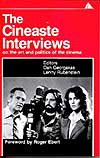 |
|
| a French word that literally means "true cinema" or "cinema truth"; a method or style of documentary movie-making with long takes, no narration and little or no directorial or editing control exerted over the finished product; usually made without actors, and often with a minimum of film equipment, a small film crew (camera and sound), impromptu interview techniques, and a hand-held camera and portable sound equipment - that solely documents the action in front of the camera; sometimes used to loosely refer to a documentary-style film or minimalist cinema; popularized in the 1950s French New Wave movement; now widely used (often inappropriately) to refer to the popular, artsy trend of using hand-held camera techniques; also termed free cinema (UK) or direct cinema (UK) |
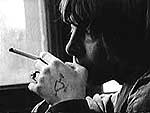 Example: the Canadian film Warrendale (1967) by Allan King, set in a school for severely disturbed children, was a classic of cinéma vérité film-making. Example: the Canadian film Warrendale (1967) by Allan King, set in a school for severely disturbed children, was a classic of cinéma vérité film-making. |
|
| the term commonly refers to widescreen processes or anamorphic techniques, that use different magnifications in the horizontal and the vertical to fill the screen; it is also the specific trademark name for 20th Century Fox's commercially-successful widescreen process which uses an aspect ratio of 2.35:1 (originally it could be as wide as 2:66:1 - to compete with Cinerama and 3-D processes in the 1950s. |
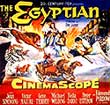 Example: 20th Century Fox's The Egyptian (1954) was shown in CinemaScope; the first CinemaScope feature was The Robe (1953). Example: 20th Century Fox's The Egyptian (1954) was shown in CinemaScope; the first CinemaScope feature was The Robe (1953). |
|
| relating to or suggestive of motion pictures; having the qualities of a film. | ||
| specifically refers to the art and technique of film photography, the capture of images, and lighting effects, or to the person expert in and responsible for capturing or recording-photographing images for a film, through the selection of visual recording devices, camera angles, film stock, lenses, framing, and arrangement of lighting; the chief cinematographer responsible for a movie is called the director of photography (or D.P.), or first cameraman; one of the earliest movie-picture machines, patented by the Lumiere brothers in 1895, was termed a Cinematographe. |  Example: Visions of Light: The Art of Cinematography (1993) profiled a history of the art of cinematography with examples from more than 125 films from some of the greatest film-makers of all time Example: Visions of Light: The Art of Cinematography (1993) profiled a history of the art of cinematography with examples from more than 125 films from some of the greatest film-makers of all time |
|
| a wide-screen filming process that first used three cameras and three projectors to achieve an encompassing view of the subject matter, and was projected on a curved screen of about 160 degrees; it was the first commercially-successful multiple-camera/multiple-screen process. |
 Examples: This is Cinerama (1952), Cinerama Holiday (1955), Seven Wonders of the World (1955), Search for Paradise (1957), South Seas Adventure (1958), How the West Was Won (1962), and The Wonderful World of the Brothers Grimm (1962). Examples: This is Cinerama (1952), Cinerama Holiday (1955), Seven Wonders of the World (1955), Search for Paradise (1957), South Seas Adventure (1958), How the West Was Won (1962), and The Wonderful World of the Brothers Grimm (1962). |
|
(clapper (board)) |
a small black or white board or slate with a hinged stick on top that displays identifying information for each shot in a movie, and is filmed at the beginning of a take. The board typically contains the working title of the movie, the names of the director, the editor, and the director of photography, the scene and take numbers, the date, and the time. On the top of the clapboard is a hinged wooden stick(called a clapstick or clapper) which is often clapped to provide audio/visual synchronization of the sound with the picture during editing; electronic clappers and synchronization are currently in use instead of the old-fashioned clapboard. |
 Example: the clapboard or slate from Hitchcock's Psycho (1960). Example: the clapboard or slate from Hitchcock's Psycho (1960). |
| refers to the animation of models constructed of clay, putty, plasticine, or other moldable materials, often through stop-motion. |  Examples: the Wallace & Gromitanimated films, and Chicken Run (2000). Examples: the Wallace & Gromitanimated films, and Chicken Run (2000). |
|
| slang denoting a 'hit' film | ||
|
a film characterized by scenes of great tension, danger, adventure, suspense, or high drama, often climaxing at the end of a film, or at the end of a multi-part serial episode, where the plot ending and the fate of the protagonist(s) are left unresolved; the name was derived from the movie serials of the 1930's where each week the hero (or heroine) was perilously left dangling from a cliff -- with a 'to-be-continued' ending -- to increase interest for the next episode (sequel). |
 A good example of early movie serial cliffhangers is The Perils of Pauline (1914), from which the term originated; also, The Empire Strikes Back (1980) ended with Lando Calrissian (Billy Dee Williams) and Chewbacca (Peter Mayhew) leaving in the Millenium Falcon to rescue frozen Han Solo (Harrison Ford) - with the unresolved issue between Darth Vader (David Prowse/James Earl Jones) and Luke Skywalker (Mark Hamill) after their climactic duel (Was Vader really Luke's father?) A good example of early movie serial cliffhangers is The Perils of Pauline (1914), from which the term originated; also, The Empire Strikes Back (1980) ended with Lando Calrissian (Billy Dee Williams) and Chewbacca (Peter Mayhew) leaving in the Millenium Falcon to rescue frozen Han Solo (Harrison Ford) - with the unresolved issue between Darth Vader (David Prowse/James Earl Jones) and Luke Skywalker (Mark Hamill) after their climactic duel (Was Vader really Luke's father?) |
|
| the highest point of anxiety or tension in a story or film in which the central character/protagonistfaces, confronts, and deals with the consequence(s) of all his/her actions, or faces the antagonist in a climactic battle or final engagement; a crisis often leads to a climax; also called the film's high point, zenith, apex, or crescendo; a climax may be followed by an anti-climax or denouement |
 Example: the two protagonists cling for their lives from Mount Rushmore in the climax of Hitchcock's North by Northwest (1959). Example: the two protagonists cling for their lives from Mount Rushmore in the climax of Hitchcock's North by Northwest (1959). |
|
| see film clip | ||
(CU) |
a shot taken from a close distance in which the scale of the object is magnified, appears relatively large and fills the entire frame to focus attention and emphasize its importance; i.e., a person's head from the shoulders or neck up is a commonly-filmed close-up; a tight shot makes the subject fill almost the entire frame; also extreme close-up (ECU or XCU) is a shot of a part of a character (e.g., face, head, hands) to emphasize detail; also known as detail shot or close on; contrast to long-shot (LS) |  Examples: an extreme close-up or tight shot from Hitchcock's Psycho (1960) 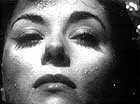 and a closeup of Becky Driscoll's (Dana Wynter) face, after Miles (Kevin McCarthy) gives her apathetic lips a kiss, and realizes that she is "one of them" in Invasion of the Body Snatchers (1956) |
| slang meaning either Hollywood or Los Angeles, both entertainment centers | ||
| literally, means "tail" in Italian, and usually refers to musical selections; in film, it refers to the epilogue, ending or last section of a film (often wordless), that provides closure, a conclusion, or a summary of the preceding storyline |  Examples: the long-view of the tree-lined road in The Third Man (1949), the final shot of the stairway in The Exorcist (1973), or the gravesite epilogue in Schindler's List (1993) Examples: the long-view of the tree-lined road in The Third Man (1949), the final shot of the stairway in The Exorcist (1973), or the gravesite epilogue in Schindler's List (1993) |
|
| a slang term for money or financing | ||
(film) |
a phenomenon of light or visual perception that enables one to differentiate otherwise identical objects caused by differing qualities of the light reflected or emitted; contrast to black and white. |
 Example: Pleasantville (1998) combined both black and white and color images in the same frame. Example: Pleasantville (1998) combined both black and white and color images in the same frame. |
| the film-altering process whereby a black and whitefilm is digitally changed to include color; popularized but controversial in the 1980s. |
|
|
(comedienne) |
an actor who specializes in genre films that are designed to elicit laughter from audiences; also known as a comic |
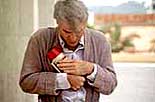 Example: Steve Martin in The Jerk (1979). Example: Steve Martin in The Jerk (1979). |
| a film with elicits laughter or humor by celebrating or showing the eternal ironies of human existence; types include screwball, dark/black, farce, slapstick, dead-pan, parody, romantic comedy, etc. | Example: See many examples in the genre section on comedy films | |
| a humorous or farcical interlude in a dramatic film, usually provided by a buffoonish character, intended to relieve the dramatic, built-up tension or heighten the emotional impact by means of contrast |  Example: Walter Huston as a grizzly prospector - dancing a jig on ground laced with gold in The Treasure of the Sierra Madre (1948) Example: Walter Huston as a grizzly prospector - dancing a jig on ground laced with gold in The Treasure of the Sierra Madre (1948) |
|
| a film associated with difficult teen rites of passage (from adolescence to adulthood), the onset of puberty, the loss of naive innocence and childhood dreams, the experience of growing up, achieving sexual identity, etc.; aka teen films |  Examples: Rebel Without A Cause (1955) with iconic James Dean, Summer of '42 (1971), American Graffiti (1973), Breaking Away (1979), the films of John Hughes Examples: Rebel Without A Cause (1955) with iconic James Dean, Summer of '42 (1971), American Graffiti (1973), Breaking Away (1979), the films of John Hughes |
|
| a great performance in a film by an actor, sometimes referring to the one before his or her death; it originally referred to a special performance that was requested by a sovereign, royal, head of state, or other important person | ||
| an objective opinion or description of characters or events occurring in the film, presented from an omniscient point of view by a commentator; the commentator's voice comes from off-camera, and is presented on the soundtrack as a voice-over; also refers to one of the added features on various DVDs in which a cast member, director, film critic, or film historian 'comments' on the film in some way |
 Example: the newsreel "News on the March" prologue to Citizen Kane (1941); also the commentary provided by critic Roger Ebert, or film directors Peter Bogdanovich or Martin Scorsese on special editions of DVDs Example: the newsreel "News on the March" prologue to Citizen Kane (1941); also the commentary provided by critic Roger Ebert, or film directors Peter Bogdanovich or Martin Scorsese on special editions of DVDs |
|
| a film made up of shots, scenes, or sequences from other films | Example: Chuck Workman's compilation film - 100 Years at the Movies (1994) | |
| a plot event that complicates or tightens the tension of a film | ||
| the musician who creates (writes or adapts) the film's musical score; contrast to a conductor (who directs the orchestra's performance of the score), or a lyricist (who writes a song's words) |
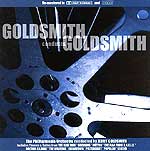 Example: Jerry Goldsmith, composer of original music for Patton (1970), Chinatown (1974), Poltergeist (1982), and many more excellent films. |
|
| refers to the arrangement of different elements (i.e., colors, shapes, figures, lines, movement, and lighting) within a frame and in a scene |
 Example: the clever composition of frames in The Sixth Sense (1999). Example: the clever composition of frames in The Sixth Sense (1999). |
|
| see earlier CGI | ||
(rock or comedy) |
a film that records the live concert performance of musician(s), a band/group, or stand-up comic(s); concert films are often edited over the course of many performances and/or staged for the camera with multiple set-ups, and can be considered pseudo-documentaries; a rock concert is aka rockumentary | Examples: famous musical rock concert films include Monterey Pop (1968), The Rolling Stones: Gimme Shelter (1970), Let It Be (1970), Woodstock (1970), George Harrison's "Concert for Bangladesh" (1972), The Last Waltz (1978), Stop Making Sense (1984), and Madonna: Truth or Dare (1991); famous stand-up comedy concert film performances include Richard Pryor: Live on the Sunset Strip (1982) and Bill Cosby, Himself (1983) |
(or continuous) |
refers to action moving through multiple locations without interruptions; it usually refers to the degree to which a film is self-consistent without errors, jump cuts, or mis-matched shots and details; the final edited structure of a completed film includes events or scenes/sequences arranged as if they had occurred continuously, when, in fact, they were shot out of sequence; a system of editing was developed in the early 20th century to provide a continuous and clear movement of events/images in a film; a continuity cut refers to a editing cut that takes the viewer seamlessly, unobtrusively, and logically from one sequence or scene to another, to propel the narrative along; a blooper or flub is a continuity error |
 Example: Error in continuity in Pretty Woman (1990) during the breakfast scene, in which Julia Roberts is first eating a croissant that quickly switches to a pancake; or the view of a gas cartridge on a Roman chariot in Gladiator (2000). Example: Error in continuity in Pretty Woman (1990) during the breakfast scene, in which Julia Roberts is first eating a croissant that quickly switches to a pancake; or the view of a gas cartridge on a Roman chariot in Gladiator (2000). |
| an actor (both stars and bit players) who has a contractual commitment or agreement to a studio/producer/company | 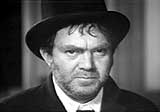 Examples: minor contract players included Ward Bond, Thomas Mitchell (pictured here as drunken Doc Boone in Stagecoach (1939)), Henry Travers, Wallace Ford, Beulah Bondi Examples: minor contract players included Ward Bond, Thomas Mitchell (pictured here as drunken Doc Boone in Stagecoach (1939)), Henry Travers, Wallace Ford, Beulah Bondi |
|
| refers to the difference between light and shadow, or between maximum and minimum amounts of light, in a particular film image; can be either high contrast(with a sharp delineation between the bright and dark areas) or its opposite low contrast; color can also be contrasted; see also chiaroscuro | ||
| the expected elements in a type of film, without question, thought, or judgment | 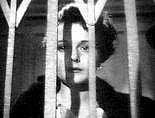 Example: Film noir is expected to be a dark, pessimistic, shadowy-filmed story about human betrayal or corruption, such as The Maltese Falcon (1941) (pictured); documentaries are expected to usually include factual information and interviews Example: Film noir is expected to be a dark, pessimistic, shadowy-filmed story about human betrayal or corruption, such as The Maltese Falcon (1941) (pictured); documentaries are expected to usually include factual information and interviews |
|
| refers to landmark legislation in the late 30s designed to protect a child actor's earnings, by depositing some of the minor's earnings in court-administered trust funds that the child receives when he/she reaches the age of majority; named after child actor Jackie Coogan |  Example: as a result of The Kid (1921) opposite Charlie Chaplin, 7-year old child actor Jackie Coogan was one of the most highly-paid actors in Hollywood, but lost his earnings to his exploitative parents Example: as a result of The Kid (1921) opposite Charlie Chaplin, 7-year old child actor Jackie Coogan was one of the most highly-paid actors in Hollywood, but lost his earnings to his exploitative parents |
|
(or wardrobe) and costume design |
refers to the garments or clothing worn by actors/performers in a film; a costume (or wardrobe) designer researches, designs, and selects the costumes to be appropriate to the film's time period, the characters, their location, and their occupations, whereas the costumer (or stylist) is responsible for acquiring, selecting, manufacturing, and/or handling the clothing and accessories; a costume drama is a film set in a particular historical time period, often with elaborate costuming |
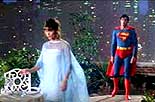 Example: Superman: The Movie (1978) (pictured); also films with important wardrobe elements include Cabaret (1972), 3 Women (1977), Ed Wood (1994), and Hedwig and the Angry Inch (2001) Example: Superman: The Movie (1978) (pictured); also films with important wardrobe elements include Cabaret (1972), 3 Women (1977), Ed Wood (1994), and Hedwig and the Angry Inch (2001) |
| a drama and/or mystery story, in which the main protagonist is a lawyer, and a majority of the drama and dramatic action takes place in a courtroom setting; the plot revolves around the preparation of a trial and its result of guilt or innocence | 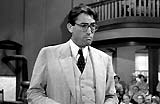 Examples: The Life of Emile Zola (1937), Adam's Rib (1949), 12 Angry Men (1957), Witness For the Prosecution (1957), Anatomy of a Murder (1959), Compulsion (1959), Inherit the Wind (1960), Judgment at Nuremberg (1961), To Kill a Mockingbird (1962) (pictured), The Verdict (1982), A Soldier's Story (1984), Suspect (1987), The Accused (1988), A Cry in the Dark (1988), Reversal of Fortune (1990), A Few Good Men (1992), Philadelphia (1993), The People Vs. Larry Flynt (1996), Primal Fear (1996) Examples: The Life of Emile Zola (1937), Adam's Rib (1949), 12 Angry Men (1957), Witness For the Prosecution (1957), Anatomy of a Murder (1959), Compulsion (1959), Inherit the Wind (1960), Judgment at Nuremberg (1961), To Kill a Mockingbird (1962) (pictured), The Verdict (1982), A Soldier's Story (1984), Suspect (1987), The Accused (1988), A Cry in the Dark (1988), Reversal of Fortune (1990), A Few Good Men (1992), Philadelphia (1993), The People Vs. Larry Flynt (1996), Primal Fear (1996) |
|
| refers to all the shots, including closeups and reverse angles, that a director takes in addition to the master shot, to make up the final product; to have proper coverage means having all the proper scenes, angles, lightings, close-ups, and directions | ||
| a camera shot taken from a large camera dolly or electronic device (a piece of apparatus, such as a crane), resembling a extendable mechanical arm (or boom), that can raise the camera up in the air above the ground 20 feet or more; the crane allows the camera to fluidly move in virtually any direction (with vertical and horizontal movement), providing shifts in levels and angles; crane shots usually provide some kind of overhead view of a scene |
 Examples: the opening, long-take sequence in Altman's The Player (1992) was shot with a crane, as was the classic 3-minute opening credits sequence of Touch of Evil (1958); also, the shot in High Noon (1952)where the Marshal is left in the empty street prior to his confrontation with the four gunman, to emphasize his isolation, rejection and vulnerability; and the spectacular shots using remote cranes in the car-chase sequence of To Live And Die In L.A. (1985). Examples: the opening, long-take sequence in Altman's The Player (1992) was shot with a crane, as was the classic 3-minute opening credits sequence of Touch of Evil (1958); also, the shot in High Noon (1952)where the Marshal is left in the empty street prior to his confrontation with the four gunman, to emphasize his isolation, rejection and vulnerability; and the spectacular shots using remote cranes in the car-chase sequence of To Live And Die In L.A. (1985). |
|
| refers to superimposed screen titles or text intended to move across, up, down, or diagonally on the screen |  Examples: the impressive opening crawl of text at the start of all Star Warsfilms; or the closing, vertical-scrolling of textual screen credits at the end of many films Examples: the impressive opening crawl of text at the start of all Star Warsfilms; or the closing, vertical-scrolling of textual screen credits at the end of many films
|
|
| in general, this term refers to the text appearing on screen - composed of a list of technical personnel, cast, and production crew of a film; specifically, it refers to the list of names and functions of persons and corporations contributing and responsible for the artistic or intellectual content of a film, such as: "Story by...", "Screenplay by...", "Photography by...", etc.; sometimes distinguished from the cast (the performers in front of the camera); see also front (or opening) credits, end (or closing) credits, or (beginning or end) titles. |
|
|
| refers to those involved in the technical production of a film who are not actual performers | ||
|
the period of highest tension just before the climaxof a film (there can be more than one); the point at which events reach their highest level of tension |
||
(or film critic, film reviewer) |
an individual who writes and/or publishes a review of a film from either an artistic or entertainment point of view. Film reviews often analyze and discuss a film's details, its content and characters, a critique of the performances, camera work, directing, editing, production, and script; film critics are usually more philosophical and theoretical than film reviewers or commentators; film criticism refers to the analysis of the narrative, historical and stylistic characteristics of film; 'critics' is sometimes abbreviated as crix. |
 Example: One of the best known and most knowledgeable film critics of all time, Chicago Tribune's Roger Ebert, known for his 'thumbs-up' and 'thumbs-down' reviews. Example: One of the best known and most knowledgeable film critics of all time, Chicago Tribune's Roger Ebert, known for his 'thumbs-up' and 'thumbs-down' reviews. |
| the editing technique of alternating, interweaving, or interspersing one narrative action (scene, sequence, or event) with another - usually in different locations or places, thus combining the two; this editing method suggests parallel action (that takes place simultaneously); often used to dramatically build tension and suspense in chase scenes, or to compare two different scenes; also known as inter-cutting or parallel editing. |  Examples: Porter's The Great Train Robbery (1903), D. W. Griffith's The Birth of a Nation (1915) and the finale of Griffith's Intolerance (1916), where the chase to save the pardoned hero from execution in the modern story is cross cut with Christ's procession to Calgary; also the scene in The Godfather (1972), where the baptism of Michael Corleone's godson is cross cut with the violent elimination of Corleone's multiple underworld rivals. Examples: Porter's The Great Train Robbery (1903), D. W. Griffith's The Birth of a Nation (1915) and the finale of Griffith's Intolerance (1916), where the chase to save the pardoned hero from execution in the modern story is cross cut with Christ's procession to Calgary; also the scene in The Godfather (1972), where the baptism of Michael Corleone's godson is cross cut with the violent elimination of Corleone's multiple underworld rivals. |
|
| refers to a fading technique that occurs in two stages: (1) fade to black, and then (2) fade to next scene; a cross-fade always involves a black or blank screen, whereas a dissolve does not | ||
and cross-over appeal |
a film or production that is made for one audience, but may easily 'cross-over' to another unexpected audience; also refers to a film, actor, or production that appeals to different demographic groups or age groups and can move between two or more distinct franchises; see also hybrid |  Examples: Cross-over films include Mira Nair's Monsoon Wedding (2001) - basically a film with Indian-oriented content that had wide international appeal and crossed multi-cultural barriers, and the same was true for Bend It Like Beckham (2002), Y Tu Mamá También (2001, Mex.) and Barbershop (2002). Similarly, the animated smash Finding Nemo (2003) appealed to both children and adult audiences, for different reasons. Cross-over stars include Humphrey Bogart as a romantic lead and as a hard-boiled detective, or James Cagney as a song-and-dance man and as a tough guy. Examples: Cross-over films include Mira Nair's Monsoon Wedding (2001) - basically a film with Indian-oriented content that had wide international appeal and crossed multi-cultural barriers, and the same was true for Bend It Like Beckham (2002), Y Tu Mamá También (2001, Mex.) and Barbershop (2002). Similarly, the animated smash Finding Nemo (2003) appealed to both children and adult audiences, for different reasons. Cross-over stars include Humphrey Bogart as a romantic lead and as a hard-boiled detective, or James Cagney as a song-and-dance man and as a tough guy. |
| a shot or image of a large group of people (often extras) in a film; CGI is now often used to film large crowd shots, to avoid huge costs associated with hiring extras |  Example: A crowd shot on the streets of NY from King Vidor's silent classic The Crowd (1928) Example: A crowd shot on the streets of NY from King Vidor's silent classic The Crowd (1928) |
|
| a signal or sign for an actor to begin performing, from either another performer, from the director, or from within the script; a cue is often the last word of one character's line(s) of dialogue, when another performer is expected to 'pick up their cue' to speak. | ||
| a device (cards, scrolling screen, teleprompter, or other mechanism) printed with dialogue provided to help an actor recite his/her lines; an electronic cue card is called a (tele)-prompter; derogatively called idiot cards or idiot sheets. | ||
| usually a non-mainstream film that attracts a small, but loyally-obsessed group of fans, and remains popular and worshipped over many years; cult films have limited but special appeal, and often have unusual or subversive elements or subject matter; they are often replayed for repeat viewings and audience participation (and group identification) as midnight movies; not to be confused with B-films(not all cult films are B-films) | 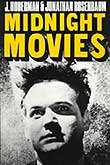 Examples: most cult films are from the horror and sci-fi genres, such as The Rocky Horror Picture Show (1975), Attack of the Killer Tomatoes! (1978), Repo Man (1984); also Harold and Maude (1971), Pink Floyd: The Wall (1982), the films of Roger Corman or David Lynch, etc. Examples: most cult films are from the horror and sci-fi genres, such as The Rocky Horror Picture Show (1975), Attack of the Killer Tomatoes! (1978), Repo Man (1984); also Harold and Maude (1971), Pink Floyd: The Wall (1982), the films of Roger Corman or David Lynch, etc. |
|
(or cutting) |
an abrupt or sudden change or jump in camera angle, location, placement, or time, from one shot to another; consists of a transition from one scene to another (a visual cut) or from one soundtrack to another (a sound cut); cutting refers to the selection, splicing and assembly by the film editor of the various shots or sequences for a reel of film, and the process of shortening a scene; also refers to the instructional word 'cut' said at the end of a take by the director to stop the action in front of the camera; cut to refers to the point at which one shot or scene is changed immediately to another; also refers to a complete edited version of a film (e.g., rough cut); also see director's cut; various types of cuts include invisible cut, smooth cut, jump cut (an abrupt cut from one scene or shot to the next), shock cut (the abrupt replacement of one image by another), etc. |  Director yelling cut! |
| a brief shot that momentarily interrupts a continuously-filmed action, by briefly inserting another related action, object, or person (sometimes not part of the principal scene or main action), followed by a cutback to the original shot; often filmed from the POV of the character and used to break up a sequence and provide some visual relief, or to ease the transition from one shot to the next, or to provide additional information, or to hint at an impending change; reaction shots are usually cutaways; cross-cutting is a series of cutaways and cutbacks indicating concurrent action; a cutaway is different from an insert shot. |
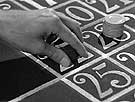 or the view of the roulette number being bet upon in Casablanca (1942) |
|
| a sub-genre of science fiction, derived from combining the terms cybernetics and punk, and related to the digital or information technology society (referring to the proliferation of computers, the online world, cyberspace, and 'hacking'); this sub-genre also incorporates classic film-noirishcharacteristics into its style - traits include alienation, dehumanization, the presence of counter-cultural anti-heroes, darkness, dystopia, and corruption; heavily influenced by the novels of Raymond Chandler; also associated with the work of writer William Gibson and his 1984 novel Neuromancer |  Examples: TRON (1982), Blade Runner (1982), Johnny Mnemonic (1995), Strange Days (1995), The Matrix (1999). Examples: TRON (1982), Blade Runner (1982), Johnny Mnemonic (1995), Strange Days (1995), The Matrix (1999). |
|
| the curved, seamless, floor-to-ceiling backdrop or background used in studio sets, often to represent the sky when outdoor scenes are shot inside | ||
źródło:www.filmsite.org

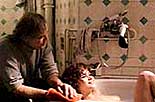
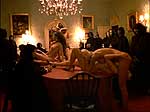

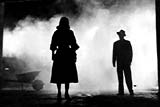 Example: commonly used in most film noirs, such as The Big Combo (1955) (pictured)
Example: commonly used in most film noirs, such as The Big Combo (1955) (pictured) Examples: The title from
Examples: The title from  and a colorized still from
and a colorized still from 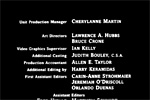
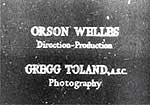 Example: The beginning of the stark credits in
Example: The beginning of the stark credits in 
 Examples: a quick cutaway shot of a newspaper headline in
Examples: a quick cutaway shot of a newspaper headline in